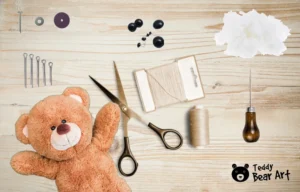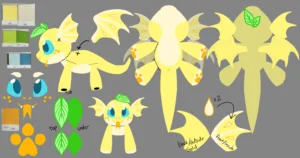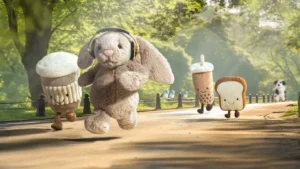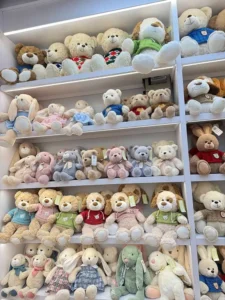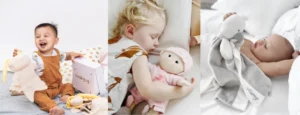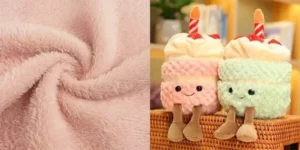If you’ve ever found yourself wondering whether there’s a difference between plush toys and stuffed animals, you’re not alone. It’s a common confusion, and while the terms are often used interchangeably, there are distinct differences between the two. Whether you’re choosing a gift, buying for a collector, or simply exploring the world of toys, understanding the difference can help you make a more informed decision.
Plush toys are often made from softer, finer materials and can have a variety of designs, while stuffed toys typically resemble animals and are filled with stuffing like cotton or polyester. The primary difference lies in their design and intended function.
In this guide, we’ll explore the key differences between plush and stuffed toys, examining their design, materials, durability, comfort, and suitability for various age groups. By the end of this article, you’ll have a clearer understanding of which toy is right for you or your loved ones.
1. What Is a Plush Toy?
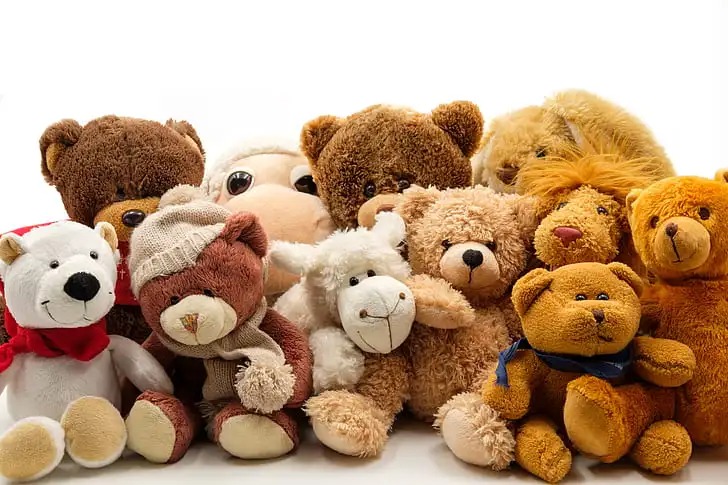
A plush toy is typically made from soft fabrics, with a smooth, plush exterior that is designed to provide a cuddly, comforting experience. Plush toys come in many shapes and sizes, often designed to evoke a sense of warmth, cuteness, and comfort. They can be made to represent animals, humans, abstract forms, or even fictional characters.
Plush toys are soft, comforting, and often designed to evoke feelings of warmth and safety. They can be made from a variety of materials and are generally more flexible in design than stuffed toys.
- Materials: Plush toys are usually crafted from soft materials such as velvet, fleece, and velboa (a velvety polyester fabric). These fabrics are chosen for their softness and plush texture, making them ideal for cuddling.
- Design: The design of plush toys is more varied than that of stuffed animals. Plush toys can take many forms, from animals and characters to abstract objects or imaginative creatures. The flexibility in design is one of the distinguishing features of plush toys.
- Durability: While plush toys are soft and comfortable, they can be more prone to wear and tear compared to stuffed animals. Their softness, while great for comfort, can lead to a loss of shape or fraying edges over time, particularly if made with delicate materials.
| Material | Description | Common Use |
|---|---|---|
| Velvet | Soft, luxurious texture | High-end plush toys, luxury items |
| Fleece | Cozy, lightweight fabric | Soft, cuddly plush toys |
| Velboa | Smooth, velvety polyester fabric | Common in mass-produced plush toys |
2. What Is a Stuffed Toy?

A stuffed toy is typically an object, often resembling an animal, that is filled with a soft material like polyester or cotton. Unlike plush toys, stuffed animals are designed to represent real creatures, often with a focus on their likeness to the real-world counterparts.
Stuffed toys are usually designed to resemble animals or people and are filled with soft materials such as polyester or cotton. They are more structured in design than plush toys.
- Materials: The stuffing in stuffed toys usually consists of cotton, polyester fiber, or foam. These materials give the toy its shape, firmness, and plush feel. The outer fabric is often less soft than that of plush toys, designed to hold the stuffed form of the toy.
- Design: Stuffed animals are generally modeled after real animals, with realistic features such as fur, paws, and faces. They are often used for educational purposes or as toys to teach children about animals.
- Durability: Stuffed animals are typically more durable than plush toys due to their denser stuffing and firmer construction. They can withstand more wear and tear, making them suitable for more active play. However, depending on the material used, they may still lose their shape over time.
| Material | Description | Common Use |
|---|---|---|
| Polyester Fiber | Synthetic, durable, soft | Common in stuffed animals |
| Cotton | Natural, hypoallergenic, breathable | Often used for baby toys |
| Foam | Soft, cushioned material | Used in premium stuffed toys |
3. How Are Plush Toys Different from Stuffed Toys in Terms of Design?
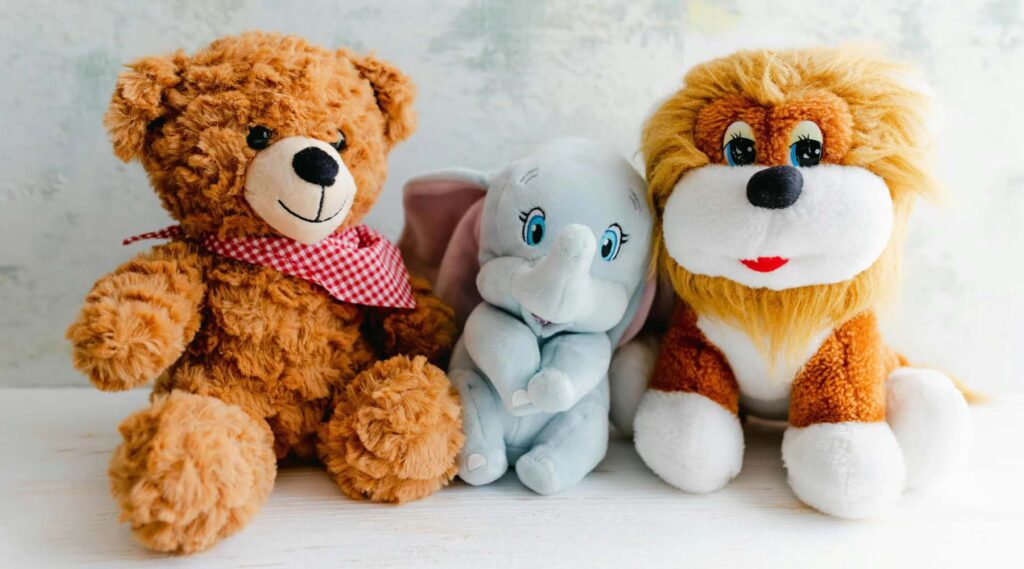
The design of plush toys is often more flexible and imaginative than that of stuffed toys. Plush toys can be based on animals, fictional creatures, or abstract shapes, whereas stuffed toys typically have more structured and realistic forms.
Plush toys are often more flexible in design, with a focus on creativity and fantasy. Stuffed toys, on the other hand, usually aim to resemble real animals or people, with realistic proportions and details.
- Creativity vs. Realism: Plush toys often embrace abstract designs, allowing for more creativity in their appearance. They can feature exaggerated features, whimsical shapes, and playful patterns. Stuffed toys, however, generally stick to more realistic depictions of animals, often based on common creatures like bears, dogs, or rabbits.
- Character Representation: Plush toys are also more commonly associated with characters from popular media, such as cartoon characters or movie stars. Stuffed animals, on the other hand, are usually representations of animals or people, designed with more natural proportions.
- Softness and Flexibility: Plush toys are often softer and more flexible in design, allowing for larger or bulkier designs that can be hugged and squeezed easily. Stuffed toys are firmer, and their structure is meant to mimic real animals, which may limit their flexibility and softness compared to plush toys.
| Design Aspect | Plush Toy | Stuffed Animal |
|---|---|---|
| Flexibility | Creative, whimsical designs | Realistic animal representations |
| Popularity | Based on characters, fantasy | Represent real-life animals |
| Softness | Softer, more flexible | Firmer, more structured |
4. Are Plush and Stuffed Toys Made from Different Materials?
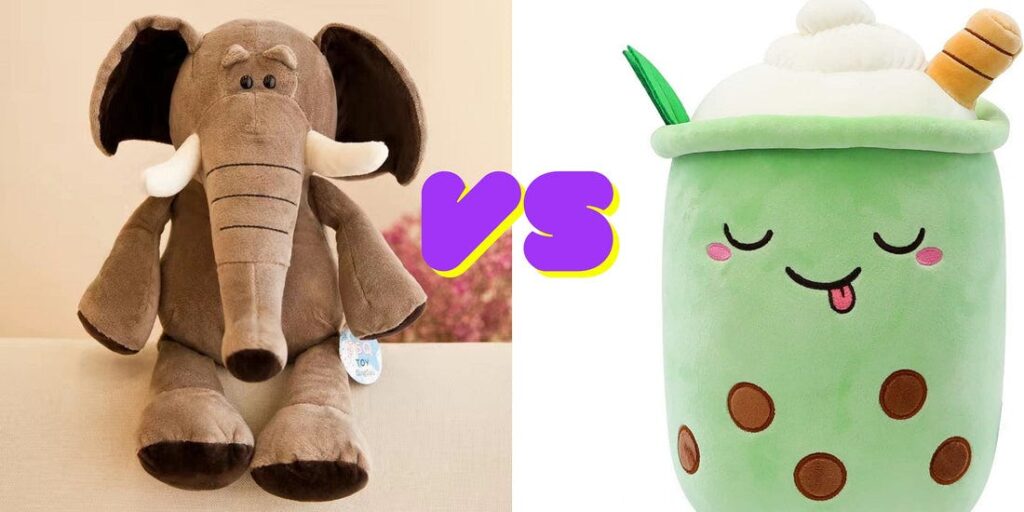
While both plush and stuffed toys share some common materials, they differ in the fabrics used for their outer coverings and their internal stuffing. Plush toys tend to use finer fabrics for their outer covering, while stuffed toys often have more robust outer materials.
Plush toys typically use softer, more luxurious fabrics, whereas stuffed toys focus on sturdier materials that can maintain the shape of the toy over time.
- Outer Fabrics: Plush toys are usually made with fabrics like velboa, velvet, or fleece, which provide a soft and luxurious feel. Stuffed toys, however, are typically made with more durable, thicker fabrics like cotton, denim, or felt, which are better suited to holding their form and withstanding the rough handling associated with active play.
- Stuffing Materials: The stuffing of a plush toy is often made from polyester fiber or cotton, which gives it a softer feel. Stuffed toys use a variety of filling materials, with polyester fiber being the most common. Some high-end stuffed animals may use foam or eco-friendly options like recycled fibers.
- Durability: Because of the tougher outer fabric and denser stuffing, stuffed toys tend to last longer and are more resistant to damage from play. Plush toys, while durable, are often more delicate and may lose their shape or fray over time if exposed to rough handling.
| Material | Plush Toy | Stuffed Animal |
|---|---|---|
| Outer Fabric | Velvet, velboa, fleece | Cotton, denim, felt |
| Stuffing | Polyester fiber, cotton | Polyester fiber, foam, recycled |
| Durability | Softer, may wear faster | More durable, built to last longer |
5. Which Type of Toy Is More Durable: Plush or Stuffed?

Durability depends on the materials used, the design, and the intended use of the toy. In general, stuffed toys tend to be more durable than plush toys, particularly when it comes to withstanding rough handling and extended use.
Stuffed toys are typically more durable due to their firmer stuffing and more structured design. Plush toys, while soft and comforting, may wear out more quickly, especially with heavy use.
- Stuffed Toys: Stuffed toys are designed to endure rougher handling, with denser stuffing that retains its shape longer. The firmer structure also makes them less susceptible to damage from frequent use. They can withstand active play, making them ideal for children or pets.
- Plush Toys: Plush toys are more delicate, as their softer filling and finer fabric tend to wear down quicker. Plush toys are often better suited to lighter handling, display, or decorative use, and they may need more frequent fluffing or care.
- Repairs and Longevity: Both plush and stuffed toys can last a long time with proper care, but stuffed toys may require fewer repairs. Plush toys, on the other hand, may require re-stuffing or more careful attention to preserve their shape.
| Durability Aspect | Plush Toy | Stuffed Animal |
|---|---|---|
| Design | Softer, more flexible, prone to wear | Firmer, longer-lasting |
| Handling | Gentle play, decorative use | Suitable for rough play |
| Repair Needs | More frequent care | Fewer repairs required |
6. How Do Plush and Stuffed Toys Differ in Terms of Comfort?
Comfort is one of the most important factors when choosing between plush and stuffed toys. Plush toys are designed for maximum softness and tactile comfort, while stuffed toys are designed to maintain their shape and durability, sometimes at the cost of softness.
Plush toys offer a higher level of comfort due to their soft and flexible materials, while stuffed toys are firmer and designed for durability, providing less softness.
- Softness and Flexibility: Plush toys excel in providing a soft, huggable experience. Their flexible construction and plush fabric make them ideal for cuddling, and they often provide a sense of emotional comfort. Stuffed animals, although soft, are typically firmer due to their dense stuffing and structured design.
- Comfort vs. Functionality: Plush toys are built for comfort, often used to offer emotional support or simply for cuddling. Stuffed animals are often more functional, serving as both toys for imaginative play and decorative items. They can be softer than plush toys in some cases, but they are less squishy.
- Use in Different Settings: Plush toys are often used as bedtime companions or in situations where comfort is paramount, while stuffed animals are better suited for interactive play or educational purposes.
| Comfort Level | Plush Toy | Stuffed Animal |
|---|---|---|
| Softness | Extremely soft, flexible | Firmer, less soft |
| Intended Use | Comfort, cuddling, emotional support | Play, learning, companionship |
| Durability vs. Comfort | May lose shape faster | Provides less comfort, more structure |
Conclusion
Plush toys and stuffed animals both have their unique characteristics, catering to different needs and preferences. Plush toys are ideal for comfort, softness, and creative design, while stuffed animals provide durability, realism, and educational value. Whether you’re looking for a cuddly companion or a toy for imaginative play, understanding these differences will help you choose the right toy for your needs.
At Kinwin, we specialize in creating high-quality, durable plush toys designed with comfort, creativity, and eco-friendly materials. If you’re interested in personalized plush toys or have any inquiries, don’t hesitate to contact us today for more information or a custom quote!




